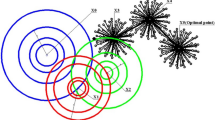Abstract
Clustering is an extensive research area in data science. The aim of clustering is to discover groups and to identify interesting patterns in datasets. Crisp (hard) clustering considers that each data point belongs to one and only one cluster. However, it is inadequate as some data points may belong to several clusters, as is the case in text categorization. Thus, we need more flexible clustering. Fuzzy clustering methods, where each data point can belong to several clusters, are an interesting alternative. Yet, seeding iterative fuzzy algorithms to achieve high quality clustering is an issue. In this paper, we propose a new linear and efficient initialization algorithm MaxMin Linear to deal with this problem. Then, we validate our theoretical results through extensive experiments on a variety of numerical real-world and artificial datasets. We also test several validity indices, including a new validity index that we propose, Transformed Standardized Fuzzy Difference (TSFD).
Access this chapter
Tax calculation will be finalised at checkout
Purchases are for personal use only
Similar content being viewed by others
Notes
References
Ruspini, E.H.: Numerical methods for fuzzy clustering. Inf. Sci. 2(3), 319–350 (1970)
MacQueen, J., et al.: Some methods for classification and analysis of multivariate observations. In: Proceedings of the Fifth Berkeley Symposium on Mathematical Statistics and Probability, Oakland, CA, USA, vol. 1, pp. 281–297 (1967)
Dunn, J.C.: A fuzzy relative of the isodata process and its use in detecting compact well-separated clusters (1973)
Bezdek, J.C., Ehrlich, R., Full, W.: FCM: the fuzzy c-means clustering algorithm. Comput. Geosci. 10(2–3), 191–203 (1984)
Kaufman, L., Rousseeuw, P.J.: Partitioning around medoids (program PAM). In: Finding Groups in Data: An Introduction to Cluster Analysis, pp. 68–125 (1990)
Steinley, D., Brusco, M.J.: Initializing k-means batch clustering: a critical evaluation of several techniques. J. Classif. 24(1), 99–121 (2007)
Maitra, R., Peterson, A.D., Ghosh, A.P.: A systematic evaluation of different methods for initializing the k-means clustering algorithm. IEEE Trans. Knowl. Data Eng. 41 (2011)
Celebi, M.E., Kingravi, H.A., Vela, P.A.: A comparative study of efficient initialization methods for the k-means clustering algorithm. Expert Syst. Appl. 40(1), 200–210 (2013)
Norušis, M.J.: IBM SPSS Statistics 19 Statistical Procedures Companion. Prentice Hall, Upper Saddle River (2012)
Faber, V.: Clustering and the continuous k-means algorithm. Los Alamos Sci. 22(138144.21), 138–144 (1994)
Hand, D.J., Krzanowski, W.J.: Optimising k-means clustering results with standard software packages. Comput. Stat. Data Anal. 49(4), 969–973 (2005)
Bradley, P.S., Fayyad, U.M.: Refining initial points for k-means clustering. In: ICML, vol. 98, pp. 91–99 (1998)
Su, T., Dy, J.G.: In search of deterministic methods for initializing k-means and Gaussian mixture clustering. Intell. Data Anal. 11(4), 319–338 (2007)
Wold, S., Esbensen, K., Geladi, P.: Principal component analysis. Chemometr. Intell. Lab. Syst. 2(1–3), 37–52 (1987)
Arthur, D., Vassilvitskii, S.: k-means++: the advantages of careful seeding. In: Proceedings of the Eighteenth Annual ACM-SIAM Symposium on Discrete Algorithms, Society for Industrial and Applied Mathematics, pp. 1027–1035 (2007)
Lance, G.N., Williams, W.T.: A general theory of classificatory sorting strategies: II. Clustering systems. Comput. J. 10(3), 271–277 (1967)
Astrahan, M.: Speech analysis by clustering, or the hyperphoneme method. Technical report, Department of Computer Science, Stanford University, CA (1970)
Gonzalez, T.F.: Clustering to minimize the maximum intercluster distance. Theoret. Comput. Sci. 38, 293–306 (1985)
Wang, W., Zhang, Y.: On fuzzy cluster validity indices. Fuzzy Sets Syst. 158(19), 2095–2117 (2007)
Bezdek, J.C.: Cluster validity with fuzzy sets (1973)
Chen, M.Y., Linkens, D.A.: Rule-base self-generation and simplification for data-driven fuzzy models. In: The 10th IEEE International Conference on Fuzzy Systems, vol. 1, pp. 424–427. IEEE (2001)
Caliński, T., Harabasz, J.: A dendrite method for cluster analysis. Commun. Stat.-Theory Methods 3(1), 1–27 (1974)
Fukuyama, Y.: A new method of choosing the number of clusters for the fuzzy c-mean method. In: Proceedings of 5th Fuzzy Systems Symposium, pp. 247–250 (1989)
Xie, X.L., Beni, G.: A validity measure for fuzzy clustering. IEEE Trans. Pattern Anal. Mach. Intell. 13(8), 841–847 (1991)
Pal, N.R., Bezdek, J.C.: On cluster validity for the fuzzy c-means model. IEEE Trans. Fuzzy Syst. 3(3), 370–379 (1995)
Park, H.S., Jun, C.H.: A simple and fast algorithm for K-medoids clustering. Expert Syst. Appl. 36(2), 3336–3341 (2009)
Bensaid, A.M., Hall, L.O., Bezdek, J.C., Clarke, L.P., Silbiger, M.L., Arrington, J.A., Murtagh, R.F.: Validity-guided (re)clustering with applications to image segmentation. IEEE Trans. Fuzzy Syst. 4(2), 112–123 (1996)
Meyer, D., Dimitriadou, E., Hornik, K., Weingessel, A., Leisch, F., Chang, C.C., Lin, C.C., Meyer, M.D.: Package e1071. Version 1.6-8 (2017)
Acknowledgements
This project is supported by the Rhône Alpes Region’s ARC 5: “Cultures, Sciences, Sociétés et Médiations” through A. Öztürk’s Ph.D. grant.
Author information
Authors and Affiliations
Corresponding author
Editor information
Editors and Affiliations
Rights and permissions
Copyright information
© 2018 Springer International Publishing AG, part of Springer Nature
About this paper
Cite this paper
Öztürk, A., Lallich, S., Darmont, J., Waksman, S.Y. (2018). MaxMin Linear Initialization for Fuzzy C-Means. In: Perner, P. (eds) Machine Learning and Data Mining in Pattern Recognition. MLDM 2018. Lecture Notes in Computer Science(), vol 10934. Springer, Cham. https://doi.org/10.1007/978-3-319-96136-1_1
Download citation
DOI: https://doi.org/10.1007/978-3-319-96136-1_1
Published:
Publisher Name: Springer, Cham
Print ISBN: 978-3-319-96135-4
Online ISBN: 978-3-319-96136-1
eBook Packages: Computer ScienceComputer Science (R0)




